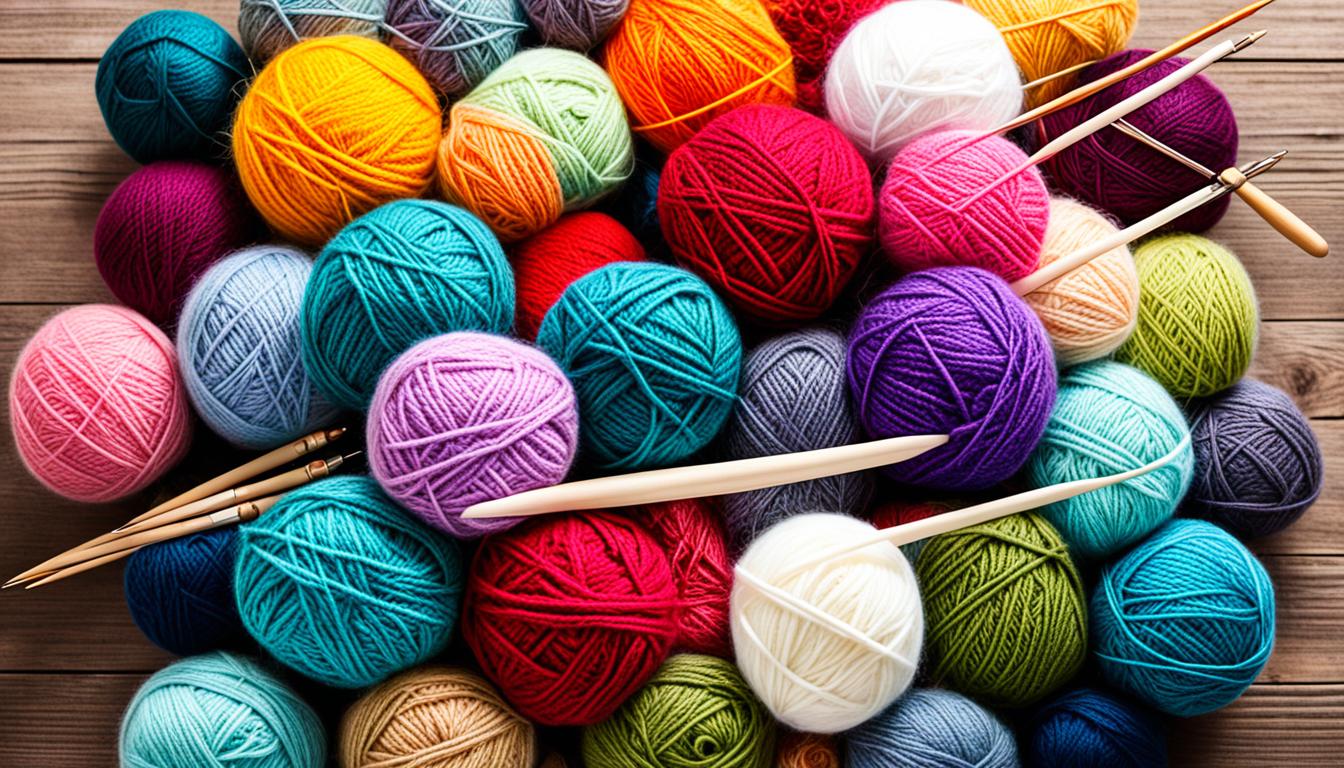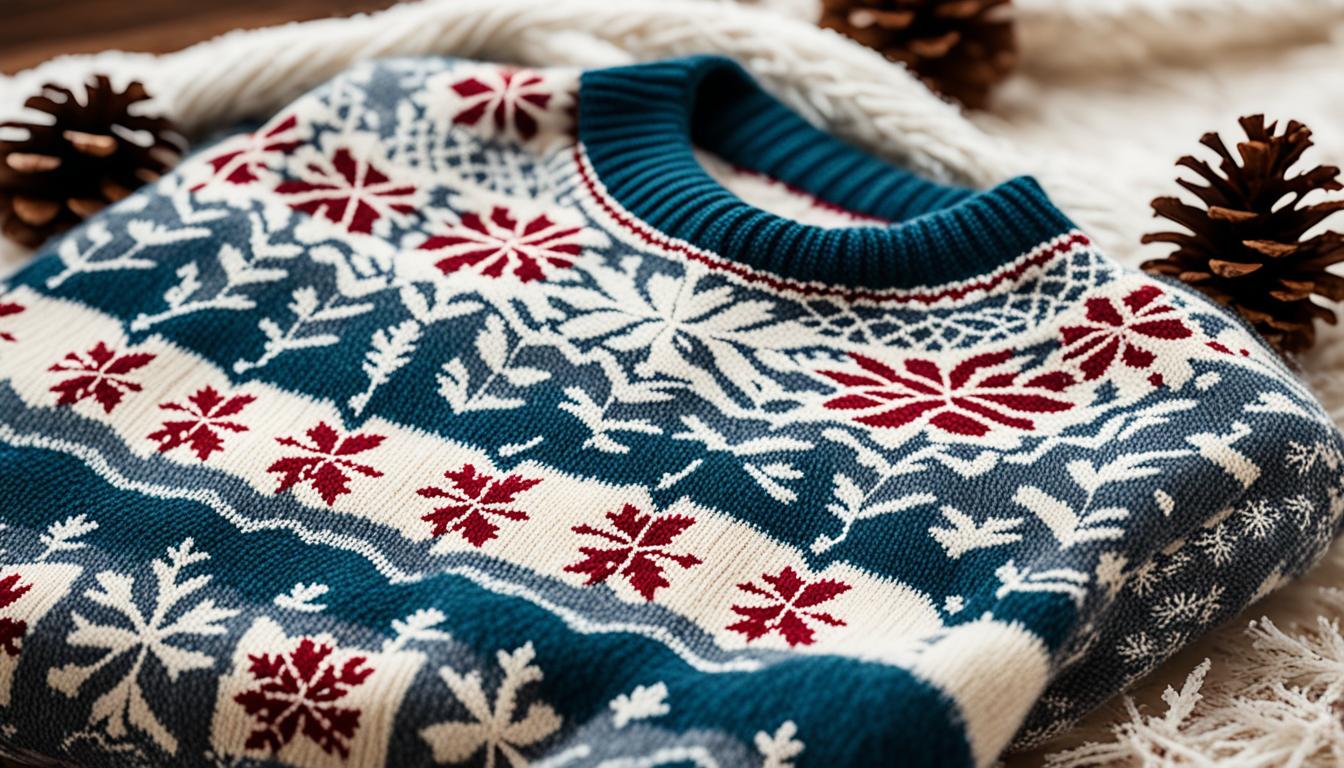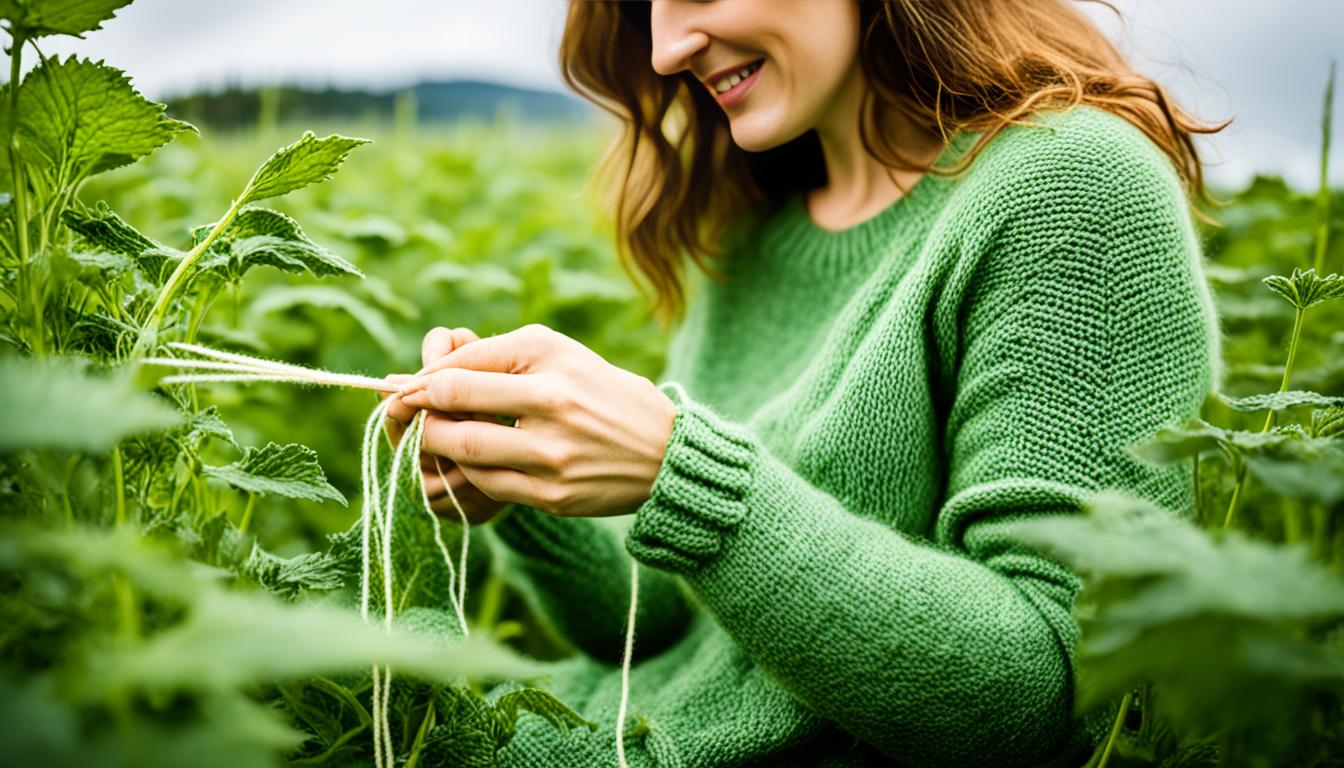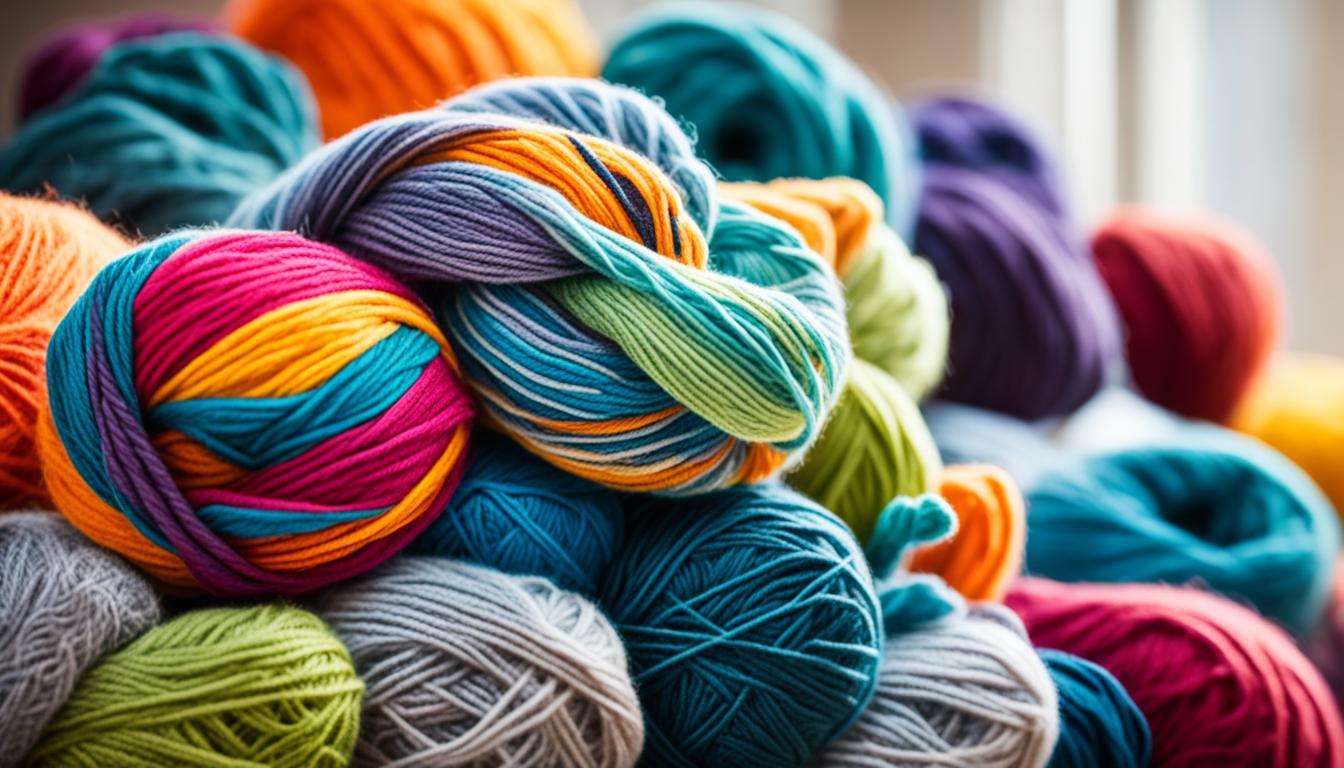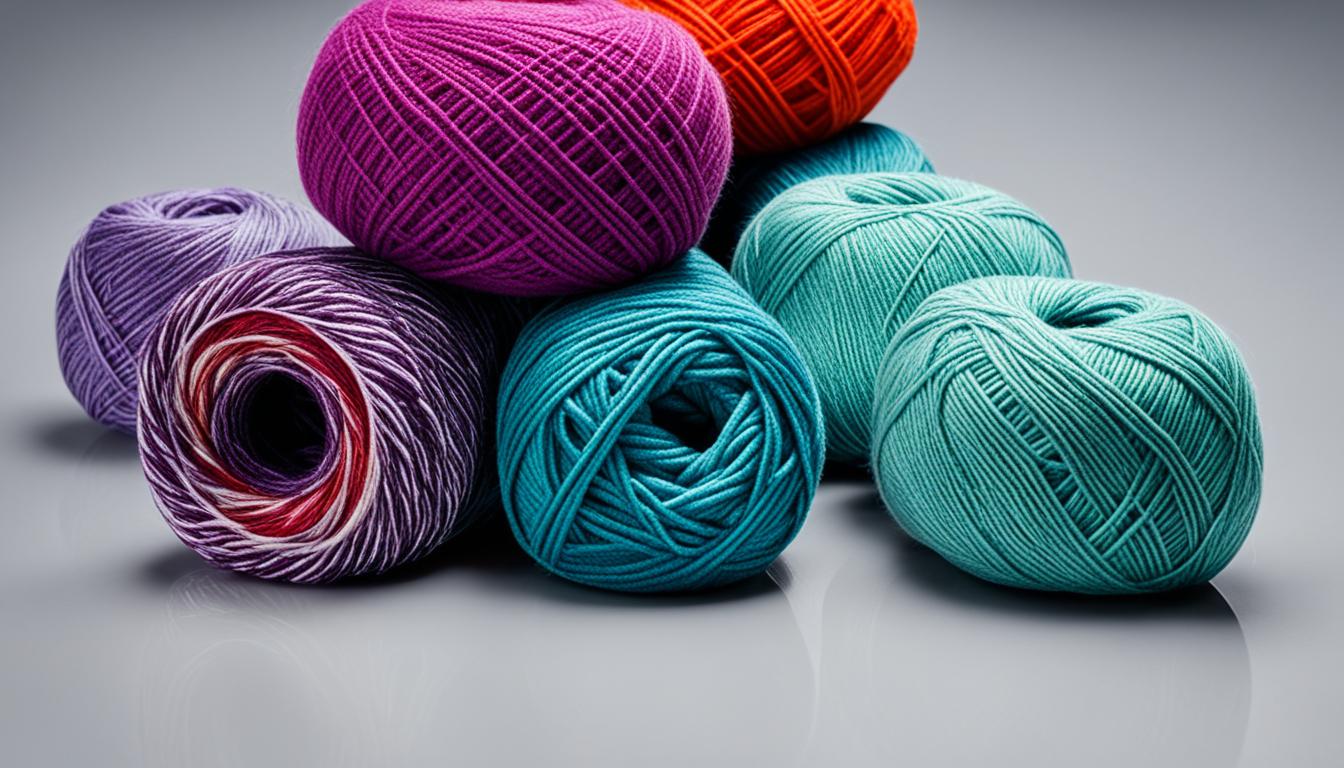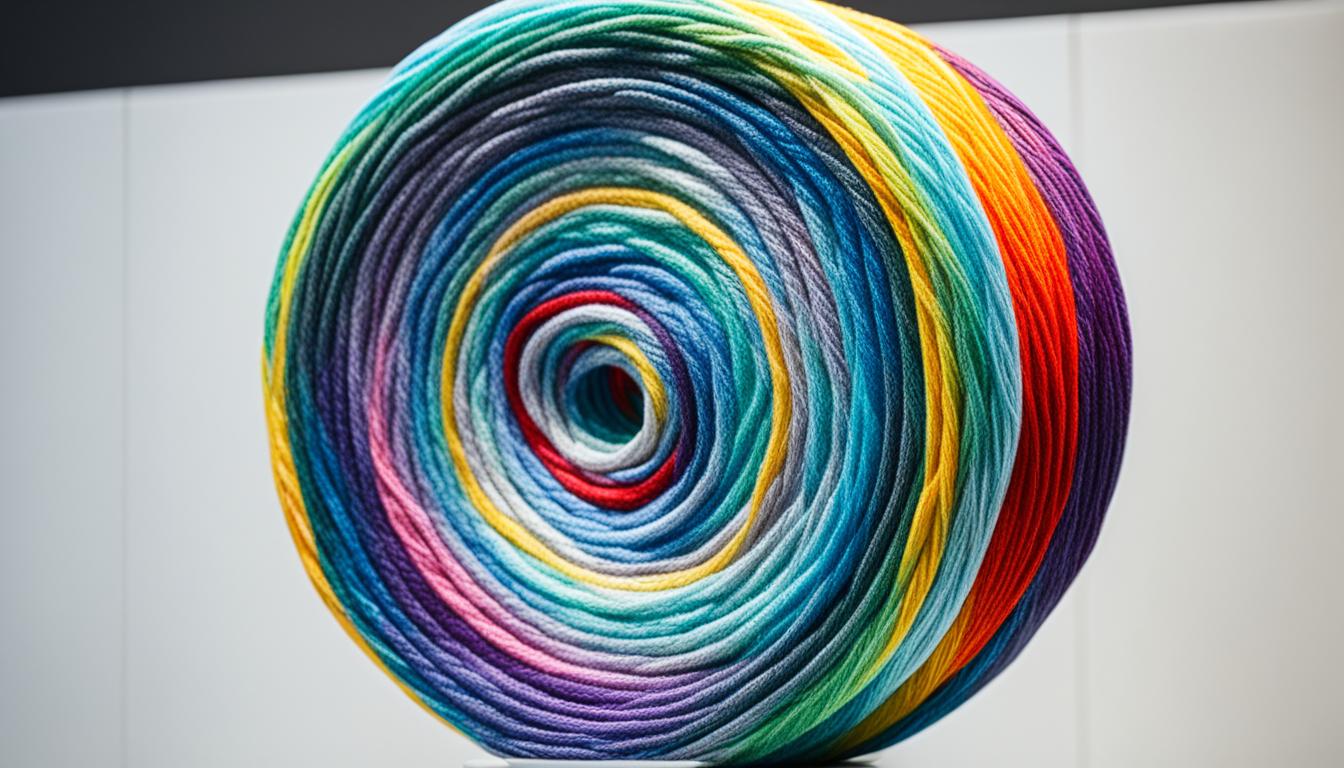Can crochet be done using knitting yarn? This topic has sparked discussions among crafters over the years. While some believe that knitting yarn is not appropriate for crochet projects, others attest to its flexibility. Today, we aim to finally resolve this debate.
When it comes to knitting and crochet, the choice of yarn plays a crucial role in the outcome of your project. But can you use knitting yarn for crochet? Are there any significant differences between knitting yarn and crochet yarn? Let’s dive in and find out.
Knitting yarn and crochet yarn can be used interchangeably without any significant difference. The properties of yarn, such as fiber content and weight, impact the outcome of both knitting and crochet projects in a similar way. Personal preferences and project requirements determine the choice of knitting or crocheting, while yarn versatility allows for creative freedom in either craft.
Key Takeaways:
- There is no real difference between knitting yarn and crochet yarn.
- Yarn properties, such as fiber content and weight, impact the outcome of knitting and crochet projects.
- Knitting yarn and crochet yarn can be used interchangeably for various projects.
- Personal preferences and project requirements determine the choice of knitting or crocheting.
- Yarn versatility allows for creative freedom in both knitting and crochet.
Understanding Yarn Basics for Knitting and Crochet
Yarn is a truly versatile material, essential for various crafts such as knitting and crocheting. As beginners venture into the world of yarn, understanding its properties becomes essential in choosing the right yarn for their knitting or crochet projects.
When comparing knitting yarn vs crochet yarn, it’s important to note that there is no specific difference between them. Both crafts utilize the same types of yarn, allowing for seamless transition between knitting and crocheting. However, different yarn weights and fiber contents can result in distinct outcomes in each craft.
Fiber Content
The fiber content of yarn determines its texture, drape, and care instructions. Natural fibers like wool, alpaca, and cotton provide warmth, softness, and breathability, while synthetic fibers like acrylic and nylon offer durability and ease of care. For beginners, exploring different fiber options can help determine personal preferences and project requirements.
Yarn Weight
Yarn weight refers to the thickness of the yarn strand. It is denoted by a numeric symbol ranging from 0 (lace weight) to 7 (jumbo weight). The yarn weight affects the overall appearance and functionality of the project. Thicker yarns create chunky and cozy fabrics, while thinner yarns produce delicate and lightweight results. Novice knitters and crocheters often find it helpful to start with medium-weight yarn (also known as worsted weight) for their first projects.
Texture
Yarn texture can add interest and dimension to knitted or crocheted items. Smooth yarns showcase intricate stitch patterns beautifully, while textured yarns like boucle or chenille create unique tactile effects. Considering texture is important in achieving the desired look and feel of the finished project.
Choosing Yarn for Beginners
For beginners, it is recommended to start with medium- or light-weight yarns that are easy to work with. These yarns provide good stitch visibility, making it easier to learn and practice new techniques. Some popular yarn choices for beginners include Red Heart Super Saver, Lion Brand Vanna’s Choice, and Caron Simply Soft. These yarns are widely available, affordable, and come in a variety of colors.
To summarize, understanding the basics of yarn is crucial for knitting and crochet enthusiasts. By familiarizing themselves with fiber content, yarn weight, and texture, beginners can confidently select the right yarn for their projects. Whether knitting or crocheting, the world of yarn opens up endless possibilities for creativity and personal expression.
Yarn Weight and Its Impact on Projects
When it comes to choosing the right yarn for your crochet projects, understanding yarn weight is essential. Yarn weight refers to the thickness of the yarn strand and greatly influences the final outcome of your project. Knitting yarn for crochet projects should be selected based on the desired fabric thickness and the specific demands of your pattern.
Thicker yarns are perfect for creating cozy garments and accessories. They produce thicker fabrics and work up quickly, making them ideal for larger crochet projects like blankets and scarves.
Thinner yarns, on the other hand, are better suited for delicate and lightweight projects. They create more intricate stitch definition and are often used for making lacy shawls, doilies, or delicate baby items.
Here’s a breakdown of the most common yarn weights and their recommended uses:
| Yarn Weight | Description | Ideal Projects |
|---|---|---|
| Fingering | Super fine yarn, often used for delicate projects | Socks, lace shawls, lightweight garments |
| Sport | Lightweight yarn, great for baby items and lightweight accessories | Baby blankets, hats, gloves |
| Worsted | Medium-weight yarn, versatile for a wide range of projects | Sweaters, blankets, scarves |
| Bulky | Chunky yarn, perfect for quick projects and cold-weather accessories | Hats, cowls, blankets |
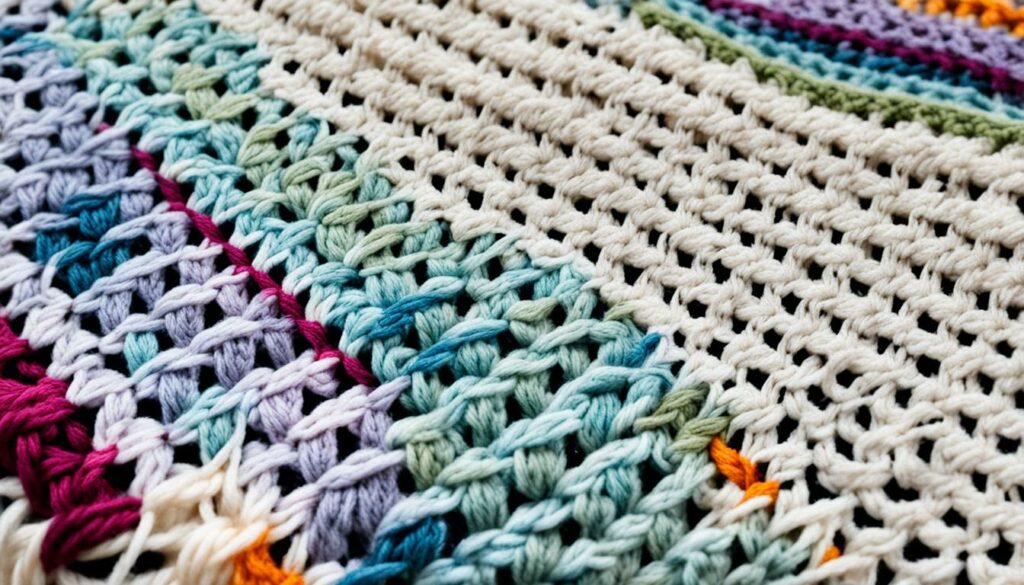
“Choosing the right yarn weight allows you to tailor your crochet projects to your specific needs and preferences.”
Keep in mind that the recommended hook size for each yarn weight may vary, so be sure to check your pattern or consult the manufacturer’s guidelines for the best results.
In the next section, we will explore the different materials available for knitting and crochet projects, helping you choose the perfect yarn for your next endeavor.
Exploring Different Yarn Materials
When it comes to crochet, the choice of yarn material is essential for creating beautiful and functional projects. From cozy winter accessories to lightweight summer garments, the right yarn can make all the difference. Let’s take a closer look at some popular yarn materials and their unique qualities.
Wool
Wool is a classic choice for crochet projects, known for its warmth and elasticity. It comes in different varieties, such as merino, cashmere, and sheep’s wool, each with its own characteristics. Wool yarn is perfect for creating cozy scarves, hats, and blankets, providing excellent insulation during colder months.
Cotton
Cotton yarn is versatile and highly sought-after, especially for lightweight and breathable projects. It is perfect for summer garments and accessories due to its ability to keep you cool and absorb moisture. Cotton yarn is also easy to care for, making it a popular choice for baby items.
Bamboo
Bamboo yarn offers a luxurious and eco-friendly alternative for crochet enthusiasts. It has a silky smooth texture, making it ideal for creating soft and drapey garments. Bamboo is naturally hypoallergenic and antimicrobial, making it a great choice for sensitive skin.
Alpaca
Alpaca yarn is known for its softness and luxurious feel. It is warmer than wool, making it perfect for cozy winter wear. Alpaca fibers are lightweight and hypoallergenic, making them suitable for those with wool allergies. Crocheting with alpaca yarn will result in beautifully textured and warm projects.
Synthetic Fibers
In addition to natural fibers, there are also synthetic yarn options available. Acrylic yarn is a popular choice for its affordability, wide range of colors, and low maintenance. It is great for beginners or those on a budget, as it offers versatility and durability.
Keep in mind that these are just a few examples of yarn materials available for crochet. Each material has its own unique qualities, so it’s essential to consider the characteristics you want for your specific project. Now that we have explored different yarn materials, let’s move on to the next section to learn about the versatility of yarn for knitting and crochet projects.
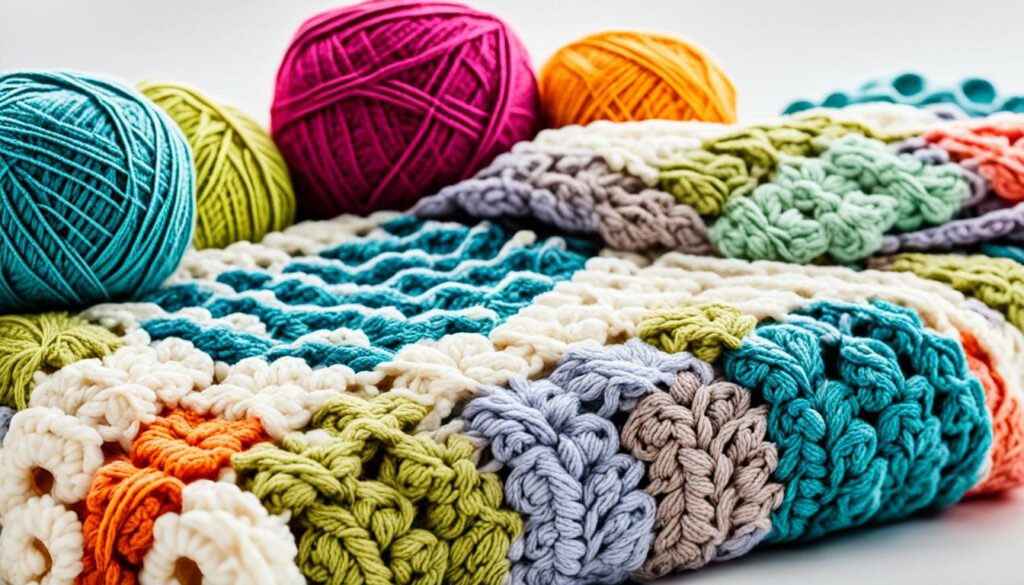
| Yarn Material | Properties | Examples |
|---|---|---|
| Wool | Warm, elastic, insulating | Merino, cashmere, sheep’s wool |
| Cotton | Lightweight, breathable, absorbent | Mercerized, organic, Pima cotton |
| Bamboo | Smooth, silky, eco-friendly | Bamboo viscose, bamboo cotton blend |
| Alpaca | Soft, luxurious, warm | Suri alpaca, Huacaya alpaca |
| Synthetic Fibers | Affordable, versatile, low maintenance | Acrylic, polyester, nylon |
Versatility of Yarn for Knitting and Crochet Projects
When it comes to working with yarn, the possibilities are endless for both knitting and crochet projects. Whether you prefer to knit or crochet, you’ll find that all types of yarn can be used interchangeably between the two crafts. There is no real difference between yarn specifically made for knitting or crochet.
When you have a favorite knitting yarn that you’d like to use for a crochet project, or vice versa, go ahead and give it a try! You’ll be pleasantly surprised by the results. The key is to adapt your knitting or crochet pattern to accommodate the yarn you’ve chosen.
By learning to adapt patterns, you’ll have the freedom to explore a wide range of knitting and crochet projects using the same yarn. Consider the project you have in mind, whether it’s a cozy scarf, a decorative throw pillow, or a cute amigurumi toy. With the right pattern and a little creativity, you can achieve stunning results.
Adapting Knitting Patterns for Crochet Projects
If you’ve found a knitting pattern that you absolutely love and want to crochet instead, it is possible to do so. When adapting a knitting pattern for crochet, keep the following tips in mind:
- Choose a crochet stitch that is similar in appearance to the knitting stitch used in the pattern. This will help you achieve a similar texture and overall look.
- Take note of the knitting pattern’s gauge and use it as a reference for choosing the right crochet hook size. Adjusting the tension is crucial to ensure your crochet project turns out the right size.
- Modify the shaping techniques if necessary. Knitting often involves increasing or decreasing stitches to shape the fabric, but in crochet, you’ll need to adapt these shaping techniques using appropriate crochet stitches.
Adapting Crochet Patterns for Knitting Projects
If you’ve come across a stunning crochet pattern and want to replicate it using knitting, don’t let the differences between the two crafts discourage you. Follow these tips to adapt a crochet pattern for knitting:
- Choose a knitting stitch that closely resembles the texture of the crochet stitch used in the pattern. This will give your knit fabric a similar look.
- Pay attention to the crochet pattern’s stitch count and use it as a reference for casting on the right number of stitches for your knitting project.
- Adjust the shaping techniques to match knitting. In crochet, shaping is often achieved by increasing or decreasing stitches, while in knitting, it involves working different types of decreases or increases.
Remember, experimenting with different yarns and patterns is part of the joy of crafting. Don’t be afraid to think outside the box and let your creativity guide you. With a little practice and patience, you’ll be able to adapt knitting and crochet patterns to work with any yarn you choose.
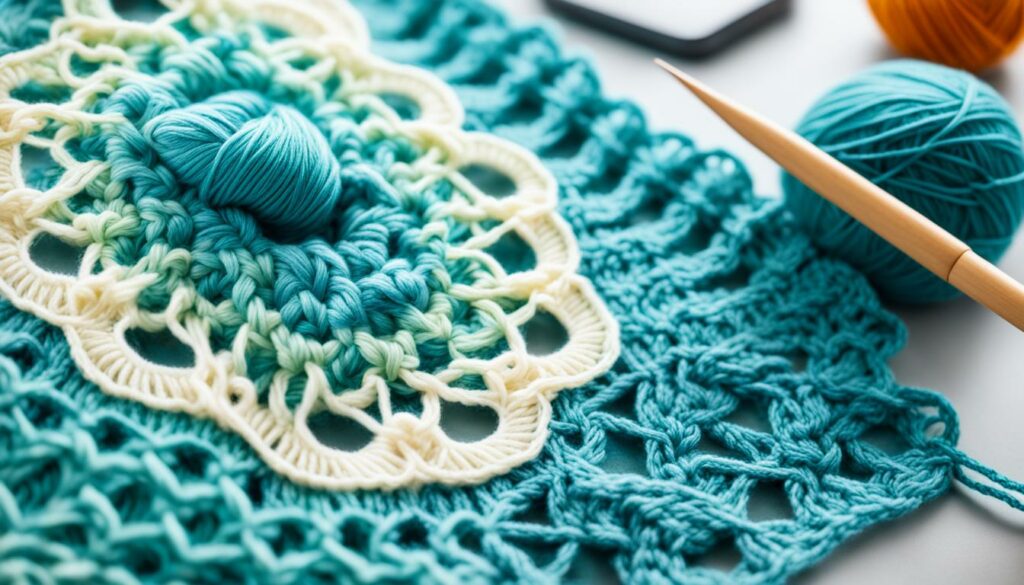
See the table below for a comparison of knitting and crochet techniques and their adaptability to different types of yarn:
| Technique | Knitting | Crochet | Adaptability |
|---|---|---|---|
| Amigurumi | No | Yes | Can be adapted with appropriate stitch substitutions |
| Lace | Yes | Yes | Both crafts are versatile for creating delicate lacework |
| Cables | Yes | Yes | Cables can be achieved in both knitting and crochet |
| Colorwork | Yes | Yes | Both crafts allow for incorporating multiple colors |
Yarn Texture and Its Impact on Stitch Patterns
Texture plays a crucial role in adding depth and interest to your knitting or crochet work. Different yarn textures can completely transform the overall appearance of a project, giving it a unique and personalized touch. Let’s explore how different yarn textures can enhance your knitting or crochet projects.
Smooth Yarns for Intricate Stitch Patterns
If you’re working on a project that features intricate stitch patterns, using smooth yarns is a great choice. Smooth yarns, such as cotton or merino wool, create a clean and polished look, allowing the intricate stitches to take center stage. The smooth texture of the yarn helps to highlight the detailed patterns and intricate designs, resulting in a visually stunning finished piece.
Textured Yarns for a Tactile Experience
If you’re looking to create projects that offer a rich and tactile experience, consider using textured yarns like boucle or eyelash yarn. These yarns have unique textures, with loops or eyelash-like strands that add dimension and interest to the fabric. The textured yarns create a visually captivating surface and make the finished project stand out. Whether you’re making scarves, blankets, or even stuffed animals, textured yarns can make your crochet or knitting projects extra special.
“Using textured yarns adds a whole new dimension to crochet and knitting. The unique tactile experience they provide makes the final projects truly special.” – Jane, experienced crafter.
When choosing the right yarn texture for your project, consider the overall aesthetic and feel you want to achieve. Smooth yarns are perfect for showcasing intricate stitch patterns, while textured yarns add a touch of whimsy and interest. Experimenting with different textures can help you create one-of-a-kind pieces that reflect your personal style and creativity.
So go ahead, embrace the variety of yarn textures available, and let them inspire your knitting and crochet projects. Mix and match smooth and textured yarns to create unique and eye-catching designs that will surely impress.
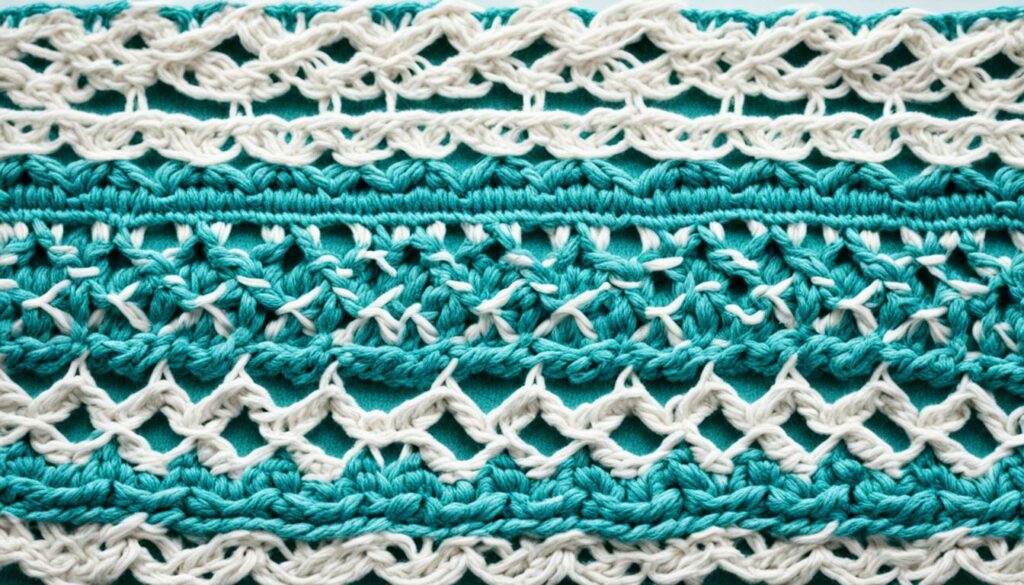
Color and Design Options with Yarn
When it comes to knitting and crochet projects, color has a remarkable impact on their visual appeal. The array of yarn colors available provides endless opportunities for creativity and self-expression. Whether you prefer bold and vibrant hues or subtle and pastel shades, there is a color that suits every taste and project.
Variegated yarns are a popular choice for adding excitement and dimension to knitting and crochet projects. These yarns feature multiple colors blended together, creating beautiful color patterns as you work. They are perfect for incorporating complexity and visual interest into your creations, effortlessly transforming simple stitches into eye-catching designs.
If you prefer a more classic and timeless look, solid shades of yarn are an excellent option. Solid-colored yarns allow the texture and stitch patterns to take center stage, resulting in elegant and sophisticated pieces. They are ideal for projects that require a clean and polished finish, such as delicate lacework or intricate cable knitting.
The art of knitting and crochet also allows for clever and creative use of multiple colors. Stripes, gradients, and ombre effects can be easily achieved by combining different shades of yarn within a project. This technique adds depth and personality to your creations, making them truly one-of-a-kind.
Here is an example of knitting and crochet designs highlighting color versatility:
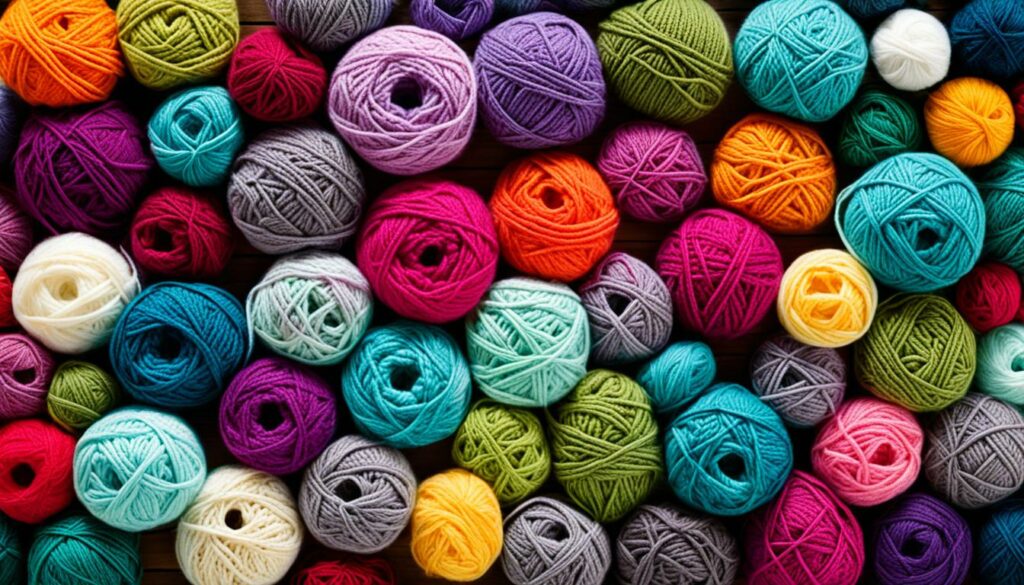
| Color Techniques | Description |
|---|---|
| Stripes | Alternating rows of different-colored yarn to create horizontal stripes. |
| Gradients | Progression of colors from light to dark or vice versa, blending seamlessly. |
| Ombre | A gradual fading effect from one color to another, usually within the same shade family. |
By incorporating various color techniques and utilizing specialty yarns, you can elevate your knitting and crochet projects to new heights of creativity. The possibilities are truly endless, and the only limit is your imagination.
Common Mistakes When Working with Yarn
When working with yarn, it’s important to be mindful of common mistakes that can occur. By avoiding these errors, we can ensure our knitting and crochet projects turn out beautifully.
Maintaining Consistent Tension
Consistent tension is crucial for achieving an even result in both knitting and crochet. If the tension varies throughout the project, the stitches may be too loose or too tight, resulting in an uneven fabric. To maintain consistent tension, practice controlling the yarn’s tension as you work, ensuring it flows smoothly through your fingers.
Avoid Dropped Stitches and Chain Mistakes
In crochet, it’s easy to accidentally drop a stitch or mistake the chain for a stitch, leading to uneven edges. When working with knitting yarn for crochet projects, take extra care to count your stitches accurately and double-check each row to avoid these mistakes. Paying attention to the pattern instructions and taking the time to count stitches can help prevent dropped stitches and chain errors.
Avoid Mixing Stitch Types
Another common mistake to avoid is mixing stitch types. Using different stitch types in the same project can lead to inconsistencies in tension and overall appearance. Stick to the recommended stitch pattern and avoid switching between knitting and crochet stitches unless the pattern specifically calls for it. This will ensure a more polished and cohesive finished project.
“By avoiding common mistakes such as inconsistent tension, dropped stitches, and mixing stitch types, we can create high-quality knitting and crochet projects.”
By following guidelines, paying attention to details, and taking our time, we can minimize mistakes and produce high-quality knitting and crochet projects. Remember, even experienced crafters make mistakes, so don’t be discouraged if you encounter challenges along the way. Learning from these mistakes will only make you a better knitter or crocheter.
| Common Mistakes | How to Avoid |
|---|---|
| Inconsistent tension | Practice maintaining tension and ensure a smooth flow of yarn. |
| Dropped stitches | Count stitches carefully and double-check each row. |
| Mixing stitch types | Stick to the recommended stitch pattern and avoid switching between knitting and crochet stitches. |
Remember, the key to successful knitting and crochet projects is patience, practice, and attention to detail. By avoiding these common mistakes, we can enjoy the process and create beautiful, high-quality items with knitting yarn for crochet projects.
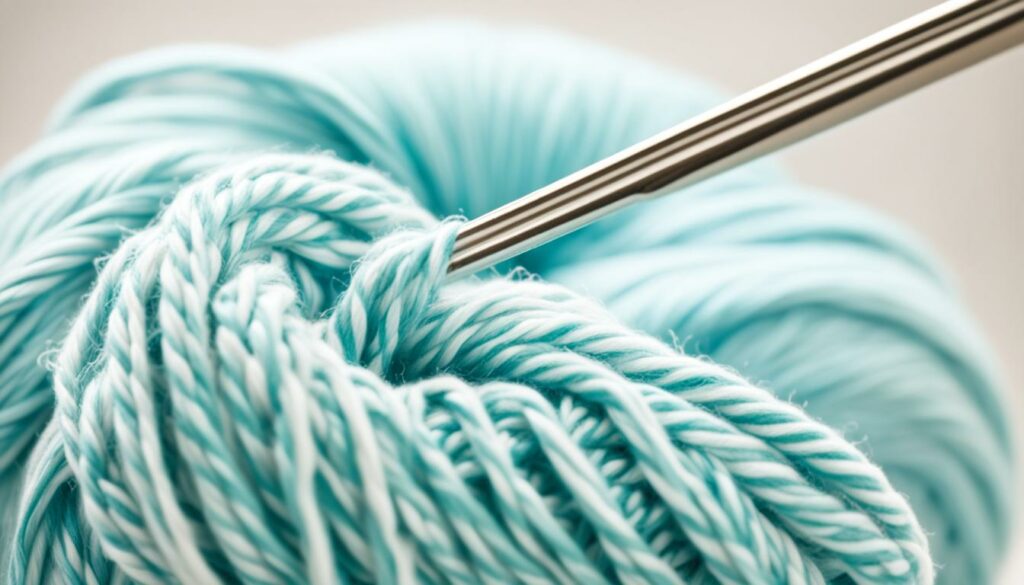
Recommended Yarns for Knitting and Crochet
When it comes to knitting and crochet projects, the selection of yarn is crucial. The right yarn can bring your creations to life and elevate your crafting experience. We’ve gathered some popular recommendations for knitting yarns that are also perfect for crochet projects. Whether you’re a knitting enthusiast venturing into the world of crochet or a seasoned crocheter looking for new yarn options, these choices are sure to inspire you.
Merino Wool Yarns:
For those who love the warmth and softness of merino wool, we recommend Drops Merino Extra Fine and Drops Big Merino. These yarns are excellent choices for both knitting and crochet projects. The fine texture of Drops Merino Extra Fine makes it ideal for delicate accessories like scarves and shawls. On the other hand, Drops Big Merino is perfect for larger projects like cozy sweaters and blankets.
Acrylic Yarn:
If you prefer affordable and easy-to-care-for yarn, Stylecraft Special DK is a top pick. This soft acrylic yarn comes in a wide range of vibrant colors, perfect for adding a pop of personality to your knitting or crochet creations. Whether you’re making hats, blankets, or toys, Stylecraft Special DK offers endless possibilities.
Cotton Yarn:
When it comes to crochet projects, cotton yarn is a popular choice. Rico creative cotton aran is a fantastic option for garments, accessories, and home decor items. Its durability and breathability make it ideal for projects that will be used or worn in warmer climates or during the summer months.
Remember, the choice of yarn ultimately depends on your specific project and personal preference. These recommendations are meant to inspire you and help you explore new possibilities in your knitting and crochet journey. Experiment, have fun, and let your creativity soar!
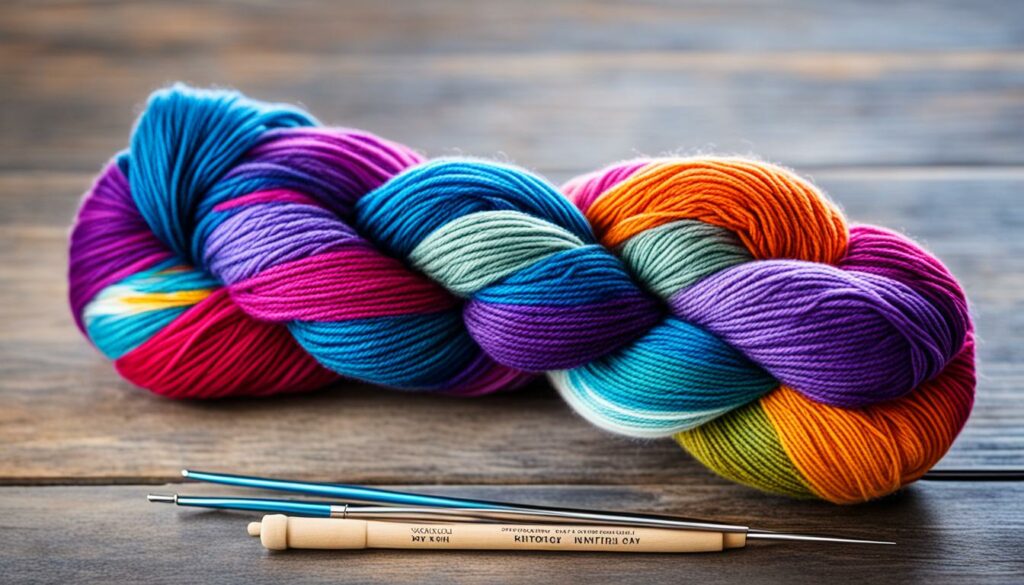
Conclusion
In conclusion, knitting yarn and crochet yarn can be used interchangeably in both crafts. Whether you prefer knitting or crochet, the choice ultimately depends on your personal preference and project requirements.
When working with yarn, it’s important to consider the properties of the yarn, such as fiber content, weight, and texture, as they impact the final outcome of your knitting or crochet projects. These factors influence the drape, warmth, and overall appearance of the finished piece.
With a wide range of yarn options available, both knitting and crochet offer endless possibilities for creativity. So, whether you’re crocheting using knitting yarn or looking for the perfect knitting yarn for your crochet projects, you’ll find that yarn is a versatile and essential material that allows you to bring your creative visions to life.
